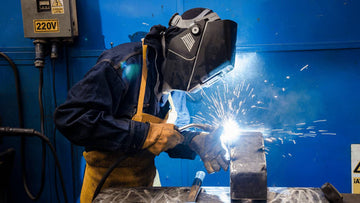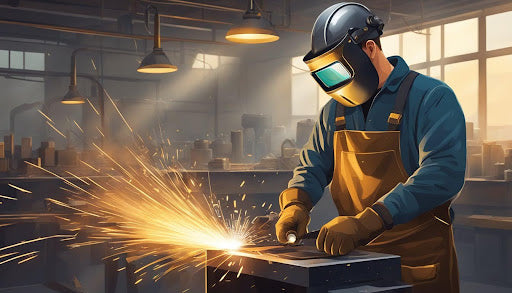
Choosing the best welder for home use is crucial, whether you're patching a garden gate or embarking on a custom car rebuild. But with the myriad of options out there, how do you determine which is the "best welder" for your garage or workshop?
In this article, we'll explore the robust world of welding and break down the essential features you need to consider when choosing a welder. We’ll explore the different types of welders suited for home projects, and, most importantly, how to stay safe while using them.
So, strap on your safety gear, and let's spark your interest in finding the best welder that’s a perfect fit for your home projects!
Types of Welders for Home Use

When it comes to welding at home, there are a variety of welder types to choose from. Each type has its advantages and disadvantages, so it's important to understand which type will work best for your needs.
MIG Welders
MIG welders are a popular choice for home welding because they are easy to use and produce high-quality welds. They work by using a wire electrode that is fed through a spool and into the welder's gun.
The wire is then melted and used to join two pieces of metal together. MIG welders are great for welding thin metals and are versatile enough to handle a variety of welding projects.
If MIG welding is what you’re interested in, then we invite you to explore our collection of beginners MIG welders.
TIG Welders
TIG welders are another popular choice for home welding because they produce high-quality welds with a clean finish. They work by using a tungsten electrode that is used to heat the metal and create a weld pool.
A filler rod is then added to the pool to create the weld. TIG welders are great for welding non-ferrous metals like aluminum and copper, but they are also more difficult to use than other welder types.
Stick Welders
Stick welders are a versatile and affordable option for home welding. They work by using a stick electrode that is coated in flux to create a shield around the weld. The electrode is then melted and used to join two pieces of metal together.
Stick welders are great for welding thicker metals and are easy to use, but they do produce a lot of splatter and require more cleanup than other welder types.
Flux-Cored Welders
Flux-cored welders are similar to MIG welders, but they use a flux-cored wire instead of a solid wire. The flux in the wire creates a shield around the weld, which means that no gas is required.
Flux-cored welders are great for welding outdoors or in windy conditions because they are less affected by air movement. They are also good for welding thicker metals and are easy to use, but they do produce a lot of smoke and require more cleanup than other welder types.
Need more information on the different welder types and what they’re used for? Read our articles on 2024 ArcCaptain Welders Buyers’ Guide.
Key Features to Consider in Choosing the Best Welders for Home Use
When looking for the best welder for home use, there are several key features you should consider. These features will help you choose a welder that meets your needs and ensures that your welding projects turn out successfully.
Power Requirements
One of the most important features to consider when choosing a welder is its power requirements. Welders come in different power ratings, which determine the thickness of the metal they can weld. When choosing a welder, you need to ensure that its power rating is suitable for the thickness of the metal you plan to weld.
Material Compatibility
Another important feature to consider is material compatibility. Some welders are designed to weld specific types of metals, while others can weld a variety of materials. When choosing a welder, you need to ensure that it is compatible with the type of metal you plan to weld.
Duty Cycle
The duty cycle of a welder refers to the amount of time it can be used continuously before it needs to cool down. When choosing a welder, you need to consider the duty cycle, especially if you plan to use it for extended periods. A welder with a higher duty cycle will be able to handle longer welding sessions without overheating.
Read more about the importance of knowing what a duty cycle is here.
Portability
Finally, portability is an important feature to consider if you need to move your welder around. Some welders are heavy and bulky, which can make them difficult to move around. If you need to move your welder frequently, consider a portable model that is lightweight and easy to carry.
Safety Equipment and Considerations
When it comes to welding, safety should always be a top priority. Here are some safety equipment and considerations you should keep in mind while welding at home.
Welding Helmets
Welding helmets are a crucial piece of protective gear for any welder. They protect your face and eyes from the intense light and heat generated during welding. When choosing a welding helmet, look for one that meets ANSI Z87.1 safety standards and has an auto-darkening lens. This type of lens automatically adjusts to the brightness of the welding arc, providing optimal visibility and protection.
Gloves and Protective Clothing
Welding gloves and protective clothing are also essential for keeping yourself safe while welding. Welding gloves should be made of heat-resistant material and cover your hands and wrists completely. Protective clothing should cover your arms, legs, and torso, and be made of flame-resistant material. You should also wear a welding apron to protect your clothing from sparks and spatter.
Ventilation and Fume Extraction
Welding produces harmful fumes and gases that can be dangerous to your health if inhaled. Proper ventilation and fume extraction are crucial for maintaining a safe working environment. You should always weld in a well-ventilated area or use a portable fume extractor to remove harmful fumes and gases from the air.
Setting Up Your Home Welding Station
When setting up a home welding station, there are a few key things to consider to ensure that you have a safe and functional workspace. In this section, we will discuss the workspace requirements, tool and accessory storage, and electrical setup.
Workspace Requirements
To start, you will need a dedicated workspace for welding that is well-ventilated and free from any flammable materials. Ideally, you should have a separate room or area in your garage or workshop that is designated for welding.
Your workspace should also have a sturdy workbench or table to hold your welding equipment and materials. The workbench should be made of non-flammable materials, such as steel or concrete, and be able to support the weight of your welding machine.
Tool and Accessory Storage
Keeping your tools and accessories organized and easily accessible is important for efficiency and safety. Consider installing shelves, cabinets, or toolboxes to store your welding helmet, gloves, clamps, and other accessories.
You may also want to invest in a welding cart to keep your welding machine and gas cylinder organized and portable. A welding cart can also provide additional storage space for your tools and accessories.
Electrical Setup
Your welding machine will require a dedicated electrical circuit to operate safely and effectively. It is recommended that you have a 220-volt electrical outlet installed by a licensed electrician.
You should also ensure that your wiring and electrical panel are up to date and can handle the electrical load required by your welding machine. It is important to follow all electrical safety guidelines and codes when setting up your welding station.
Conclusion on the Best Welders for Home Use
Choosing the right welder for your home workshop can unlock a world of creative possibilities. Consider features, types, and safety when making your decision. Whether you prefer MIG, TIG, or stick welding, there's a machine suited to your needs and skill level.
Prioritize safety alongside functionality to ensure enjoyable and successful welding sessions. With these insights, you're ready to make an informed choice that balances power, precision, and protection. Get ready to bring your metalwork dreams to life!
Ready to start welding? Check out ArcCaptain's collection of welding machines and safety gear, such as welder caps, welding aprons, and gloves, to equip your workshop with quality tools and protection.
Frequently Asked Questions on the Best Welders for Home Use
Where can I get the best welders for home use?
For the best welders suited for home use, ArcCaptain offers a wide selection of high-quality welding machines. Their collection includes various types of welders, from beginner-friendly MIG welders to versatile multi-process machines, all designed with home users in mind.
ArcCaptain's welders are known for their reliability, user-friendly features, and excellent value for money.
Is MIG or TIG welding better for home?
MIG welding is generally better for home use because it is easier to learn and can handle a wider range of materials. TIG welding is more difficult to learn but produces higher quality welds, especially on non-ferrous metals like aluminum.
What is the best welder for beginners?
For beginners, a MIG welder is the best choice because it is easy to learn and can handle a variety of materials. Look for a welder with a simple interface and adjustable settings to help you get started.
What is the easiest welding to do at home?
MIG welding is the easiest welding to do at home because it is easy to learn and can handle a wide range of materials. It also produces a clean, smooth weld that requires minimal cleanup.
What size welder for home use?
The size of welder you need for home use depends on the type of welding you plan to do and the thickness of the materials you will be welding. For most home welding projects, a 110V MIG welder with a 140-amp output is sufficient.
Can I use a MIG welder at home?
Yes, you can use a MIG welder at home as long as you have a power source and proper ventilation. Make sure to read the instructions and safety guidelines before using a MIG welder at home.
